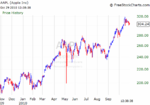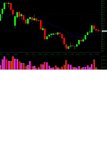Hi everyone
I always trade breakouts never retracements beacuse I always get burnt. With breakouts the direction that the stock is taking is obvious and the stop are easier set.
I guess that many many people use the same strategy since there are thousend of followers of William Oneill, Darvas and Livermore etc. All of them say that volume was very important to determine if it was a True Breakout. William Oneill says that is not that difficult to find tru breakouts but Darvas also say that his system will only be right half the time that is 50% of the time.
I guess that Oneill says that is easy to find to breakout just looking at the volume but if you are not sit infront of the computer the whole day it may not be that easy, that is probably why Darvas say that his system was going to work only half the time beacuse he did not know untile the day after the volume of the breakout.
One of the most simple solutions may be to wait for the breakout to happen and then enter the trade the day after when you see that the breakout was on big volume, one of the problems of this is that sometimes the price runsaway from the breakout point and then yor risk is higher.
Please could you share some techniques that you use to face this problem, at the moment what Darvas says is correct, Im correct about half the time and Im doing ok since I set up the stop loss very close and my wins are bigger than my losses but I will like to increase the entry percentage to 60% and put the odds more in my favor I know than higher than 60% is very unrealistic since no method is perfect.
Thanks
I always trade breakouts never retracements beacuse I always get burnt. With breakouts the direction that the stock is taking is obvious and the stop are easier set.
I guess that many many people use the same strategy since there are thousend of followers of William Oneill, Darvas and Livermore etc. All of them say that volume was very important to determine if it was a True Breakout. William Oneill says that is not that difficult to find tru breakouts but Darvas also say that his system will only be right half the time that is 50% of the time.
I guess that Oneill says that is easy to find to breakout just looking at the volume but if you are not sit infront of the computer the whole day it may not be that easy, that is probably why Darvas say that his system was going to work only half the time beacuse he did not know untile the day after the volume of the breakout.
One of the most simple solutions may be to wait for the breakout to happen and then enter the trade the day after when you see that the breakout was on big volume, one of the problems of this is that sometimes the price runsaway from the breakout point and then yor risk is higher.
Please could you share some techniques that you use to face this problem, at the moment what Darvas says is correct, Im correct about half the time and Im doing ok since I set up the stop loss very close and my wins are bigger than my losses but I will like to increase the entry percentage to 60% and put the odds more in my favor I know than higher than 60% is very unrealistic since no method is perfect.
Thanks



